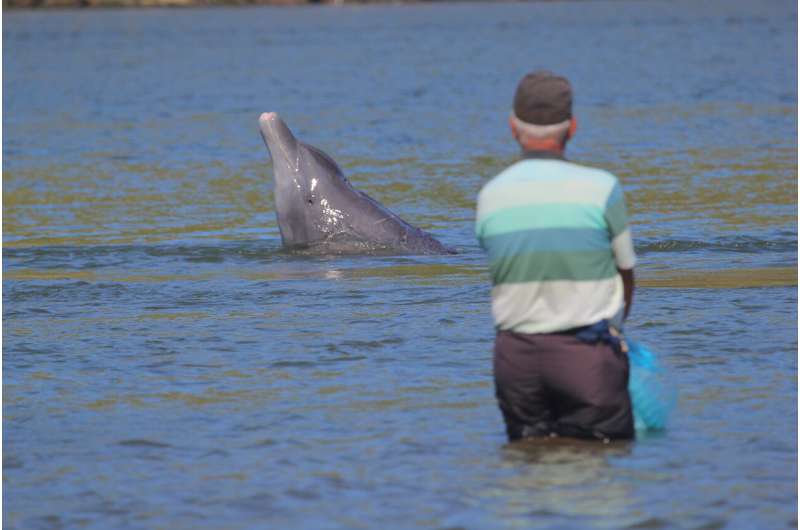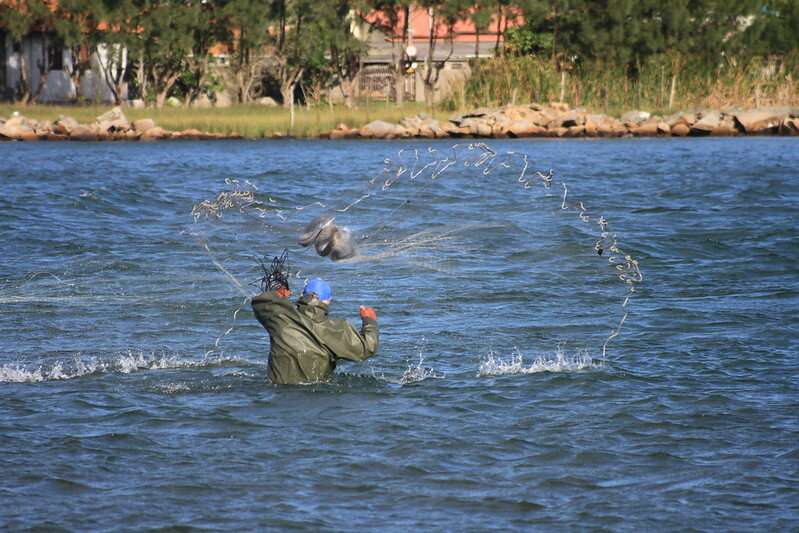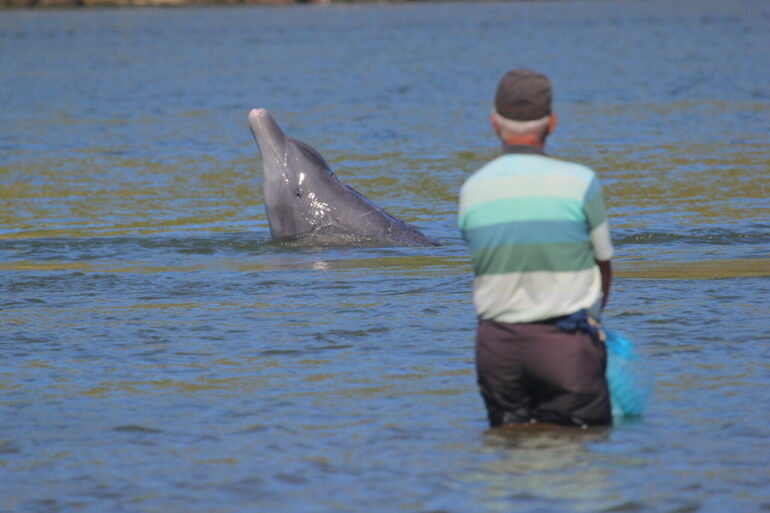By working together, dolphins and net-casting fishers in Brazil each catch more fish, a rare example of an interaction by two top predators that is beneficial to both parties, researchers have concluded following 15 years of study of the practice.
“We knew that the fishers were observing the dolphins’ behavior to determine when to cast their nets, but we didn’t know if the dolphins were actively coordinating their behavior with the fishers,” said Mauricio Cantor of Oregon State University’s Marine Mammal Institute, who led the study.
“Using drones and underwater imaging, we could observe the behaviors of fishers and dolphins with unprecedented detail and found that they catch more fish by working in synchrony,” said Cantor, an assistant professor in OSU’s College of Agricultural Sciences. “This shows that this is a mutually beneficial interaction between the humans and the dolphins.”
The researchers’ findings were just published in the Proceedings of the National Academy of Sciences. Co-authors of the paper are Professor Fábio Daura-Jorge of the Universidade Federal de Santa Catarina in Brazil and Professor Damien Farine of the University of Zurich and the Australian National University.
Synchronized movements of flocks of birds and schools of fish are a common yet striking behavior that can be key to the animals’ survival. Synchronized behavior between species, like that between the Lahille’s bottlenose dolphins and the traditional net-casting fishers in Brazil, is much more rare.
The practice is considered a cultural tradition in the city of Laguna on Brazil’s southern coast, where it occurred for more than 140 years and has been passed down through generations of fishers and dolphins. The cooperative fishing relationship is specific to this population of dolphins and is not a genetic trait in the animals, Cantor said.
There are historical and recent accounts of similar behaviors in a handful of locations elsewhere in the world, but the practice is in decline or has disappeared completely in most places and remains almost completely unstudied in others. The rare nature of the practice is one reason the practice in Brazil is being considered for a cultural heritage designation, he said.

A dolphin giving a cue to a fisher at Praia da Tesoura in Laguna, Brazil. © Dr. Bianca Romeu, Departamento de Ecologia e Zoologia, Universidade Federal de Santa Catarina; Florianópolis, SC 88040-900, Brazil.
“From the fishers’ perspective, this practice is part of the culture of the community in all kinds of ways,” Cantor said. “They acquire skills passed down from other fishers and knowledge is spread through social learning. They also feel connected to this place and have a sense of belonging to the community.”
Predictive models run as part of the study show that the future of the practice could be threatened if populations of mullet—the type of fish both dolphins and people are seeking—continue to decline, or future generations of fishers lose interest in learning the art of this unique fishing practice.
“The practice is unlikely to continue if either the dolphins or the fishers no longer benefit from it,” said Farine.
Daura-Jorge said researchers are already seeing early signs of decline in the practice. “If we take steps to document and conserve the knowledge and the culture of the practice, we can indirectly and positively impact the biological aspects, as well,” he said.
To better understand this cultural tradition and measure its short- and long-term consequences for both fishers and dolphins, the researchers combined drones, hydrophones and underwater cameras to capture the mechanics of the partnership, conducted long-term demographic surveys for dolphins and interviewed and observed the fishers.
They found that foraging synchrony between dolphins and fishers substantially increases the probability of catching fish and the number of fish caught. This benefit then supports the dolphins’ survival—dolphins who engage in cooperative fishing in this area have a 13% increase in survival rates—and the socioeconomic wellbeing of the fishers. They also found that the fishers’ understanding of the fishing tradition matched the evidence produced through scientific tools and methods.
“Questionnaires and direct observations are different ways to look at the same phenomenon, and they match up well,” Cantor said. “By integrating these together, we could then get the most complete and reliable picture of how this system works and, most importantly, how it benefits both fishers and dolphins.”

An artisanal net-caster fishes in Laguna, Brazil. © Fabio G. Daura-Jorge, Departamento de Ecologia e Zoologia, Universidade Federal de Santa Catarina, Florianópolis SC, Brazil
Most interspecific interactions, including those between humans and other animals, are competitive rather than mutually beneficial, the researchers said.
“But not in this case,” Farine said. “This makes this system of substantial scientific interest, as it can help us to understand under what conditions cooperation can evolve and—of growing importance in our rapidly changing world—under what conditions it might go extinct, or flip from a cooperative to a competitive interaction.”
The researchers suggest conservation action is needed to ensure the future of the practice. Both the dolphins and the fishers are reliant on a strong and healthy fish population for the cooperative relationship to succeed. In recent years, the region has seen reduced availability of fish. There is also reduced interest in learning the tradition, said Daura-Jorge, who has been monitoring this population for the past 15 years.
“We don’t know what is going to happen in the future, but our best guess, using our best data and best models, is that if things keep going the way they are right now, there will be a time when the interaction will no longer be of interest by at least one of the predators—the dolphins or the fishers,” Daura-Jorge said.
The researchers suggest several conservation measures may be necessary to secure the future of the practice. First is to try to identify the source of the mullet decline and take measures to better manage that species, such as reducing use of illegal nets through law enforcement, Daura-Jorge said.
Second, the researchers recommend steps to work with current and future artisanal fishers, stressing the cultural and economic importance of the net-casting practice. That might include offering incentives to encourage the traditional practice, such as setting a premium price for fish caught with this method.
“This phenomenon of mutually-beneficial interaction between wildlife and humans is getting more and more rare and seems to be at global risk,” Cantor said. “The cultural value and the biological diversity are important, and it’s important to preserve it.”
More information:
Cantor, Mauricio, Foraging synchrony drives resilience in human–dolphin mutualism, Proceedings of the National Academy of Sciences (2023). DOI: 10.1073/pnas.2207739120. doi.org/10.1073/pnas.2207739120
Provided by
Oregon State University
Citation:
Fishing in synchrony brings mutual benefits for dolphins and people in Brazil, research shows (2023, January 30)



